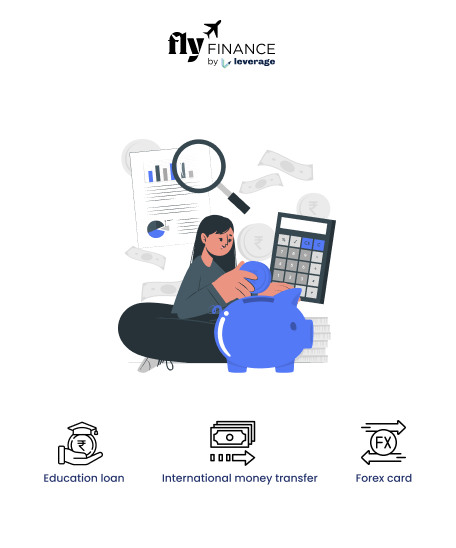There are mainly two types of education loans – secured education loans and unsecured education loans. The two differ in terms of the requirement for collateral. While you need to provide collateral for getting a secured education loan, there is no such requirement when it comes to unsecured education loans. In this blog, we’ll understand the process of applying for a secured educational loan, but first, let’s look at its meaning.
Table of contents
Meaning of Secured Education Loan
As already stated, you need to provide collateral to get a secured education loan. Keeping collateral gives an assurance to the lender that the borrower will repay the loan amount on time, and in case of failure to repay the loan, the lender can forfeit the collateral. The collateral that you provide can either be a physical asset like a flat or apartment or a non-physical asset like fixed deposits and life insurance policies.
If you are planning to take a secured education loan and want to know more about this, then you must check out this blog: All About Secured Education Loan: Benefits, Eligibility, Interest Rates & More
Secured Education Loan Application Process
The process of applying for a secured education loan starts by researching and choosing the right lender. You’ll have to check the websites of a few banks like the SBI, HDFC Bank, etc., and compare their interest rates, moratorium periods, repayment terms, and other terms and conditions. Once you have chosen your bank, you’ll have to gather the required documents and start filling out the loan application form. Let’s look at the entire process in detail.
Filling Out the Application Form
The first step is to fill out your application form after choosing the bank. For example, let’s consider that you are applying for a secured education loan from the SBI Bank then you’ll have to visit the bank’s website and fill out your basic details. The things that you’ll need to fill out in the form include:
- Course Details
- Course Fee
- Applicant Details
- Co-applicant Details
- Contact Details
Your application will look similar to the one given in the image below. After you’ve filled out the application form, you can also track its progress on the bank’s website.
It must be noted that when you apply for an education loan, you are considered the applicant or the primary borrower and you also need to provide the details of the co-applicant/guarantor. In case you fail to repay the loan then the burden to repay the loan will fall onto the co-applicant.
Verification by the Bank
After you have submitted the application form, your bank will contact you for further details like the nature of your course, your course fee structure, the potential scope of your course, and so on. The information that you provide to your bank should be correct, and the bank will use this information to assess whether you’ll be able to repay the loan or not. The bank may also ask you questions about your academic history to understand whether you are a suitable candidate for the loan or not.
Submission of Documents
A crucial part of the application process is the submission of documents. The most important document that your bank will ask you for is your acceptance letter from the university you are taking admission to. The bank may also contact your university to confirm your enrollment. Also, if your education loan amount exceeds INR 7.5 Lakhs then your bank may ask you to provide collateral documents. The documentation part will vary depending on which bank you are seeking a loan from. Below is the list of documents that most banks usually ask for:
- Proof of identity
- Proof of residence
- Passport
- 10th and 12th class mark sheet
- Passport size photographs
- Bank statements (in case of any previous loans)
The bank will also require documents from the co-applicant and guarantor and you need to check with your bank for specific details about these documents.
Loan Approval
Before approving your loan, the bank will check the applicant’s and co-applicant’s credit background to determine whether the borrower will be able to repay the loan or not. After the bank verifies your documents and checks your suitability, you will be issued a ‘loan sanction letter’. If you accept the terms and conditions mentioned in the sanction letter, the bank will contact you to execute loan disbursement and you will also be asked to submit the original documents of the collateral to the bank.
Loan Disbursement
Loan disbursement is the process by which the lender transfers the loan amount to the borrower and it forms the final part of the education loan process. Banks will usually disburse the loan to your respective college or university through a demand draft, cheque, etc. depending on the bank and the university.
To understand the difference between secured and unsecured education loans you must read this blog: Secured Vs. Unsecured Education Loan: What’s the Difference?
FAQs
To apply for a secured education loan, you are required to fill out the loan application form on the bank’s official website.
You will need to submit the following documents for an education loan:
-Proof of identity
-Proof of residence
-Passport
-10th and 12th class mark sheet
-Passport-size photographs
-Bank statements (in case of any previous loans)
-Acceptance letter from the institution
-Collateral documents in case of secured education loan
You’ll have to provide collateral when your loan amount exceeds INR 7.5 Lakhs. And, you must check with your bank to know the specific details about the collateral requirement.
This blog was all about the application process for secured education loans. To know more about the loan application process, the best international bank accounts for students, forex and banking experience for global students or international money transfers, reach out to our experts at 1800572126 to help ease your study abroad experience.
Follow Us on Social Media





























